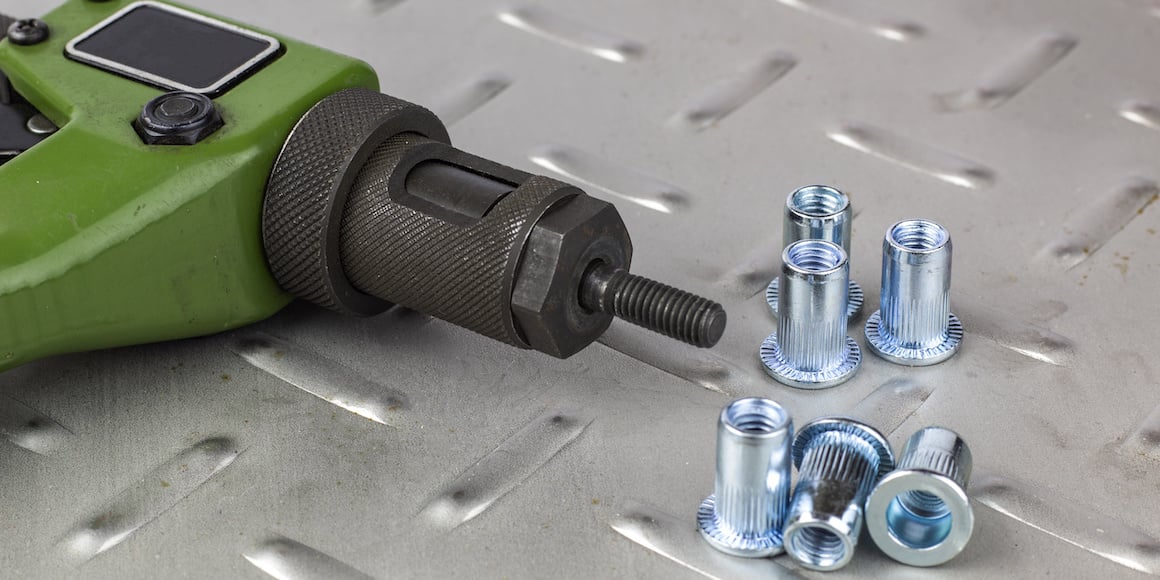
There are different fasteners for different applications. If you want a permanent bond, rivets or blind bolts may be your best option. A rivet nut may be a better choice if you want a strong join that can be set with a screw so it can be serviced or replaced.
Rivet nuts are a type of blind bolt that are tough and provide a lasting join, but they are threaded on the inside to accommodate a bolt. They are handy for applications where you need a secure and lasting joint, but you also want to be able to remove whatever is screwed into the rivet joint from time to time. For example, rivet joints can be useful on a car engine or machine chassis where you may need to replace a part or for consumer electronics to install a circuit board.
There are two basic rivet nut installation designs:
- The first design creates a bulge to secure the rivet nut on the back side, and the bolt is tightened in the insert.
- The second design draws in the sleeve when the bolt is tightened to press against the sides of the pre-drilled hole, thus creating a strong bond.
The great thing about rivet nuts is they can create a lasting bond in any material. That’s why they are popular with thin materials, such as consumer electronics, or soft materials used to make furniture, such as pine. Rivet nuts are easy to install and highly versatile.
Basic Rivet Nut Types
Although rivet nuts have only two basic types of installation, they come in various configurations and types:
- Thick wall inserts, sometimes called nutserts, are the original rivet nut developed in the 1930s for airplane manufacturing. They usually have round or hexagonal bodies and are available in different sizes, thicknesses, and materials for other uses.
- Thin wall inserts are similar to thick wall inserts and come in round and hexagonal designs but are thinner and lighter. They also come in closed-end designs with knurled bodies and can come with weather-resistant coatings,
- Slotted body inserts have slots in the body shaft so they will bulb and collapse on the blind side when installed,
- Euro-style rivet nut inserts use metric measurements and come in round, semihexagonal, full hexagonal, and square body types.
- Stud-style inserts are for applications where you want to use a nut rather than a bolt. They have a hexagonal or knurled shaft to prevent turning and provide a solid threaded stud that can accept a nut.
Matching Rivet Nuts to the Material
When choosing the proper rivet nut, the most important thing is to match the rivet nut to the material.
For example, for softer materials such as wood or plastic, use a rivet nut made of a softer material such as brass or aluminum. Use a knurled or hexagonal rivet body design to prevent pullout or turning. For harder or thicker workpieces, consider using a harder material such as steel or stainless steel.
Consider using plastic rivet nut inserts for plastics such as PVC pipes or PTFE materials. Using a softer insert material that matches the workpiece will provide longer service, whereas a harder type of insert, such as steel, may cut through the plastic.
Rivet nut inserts are not affected by heat and use a cold installation, unlike welding. So rivet nuts are ideal for solar installations, wooden furniture, pools, electronics, and other applications where applying heat is ill-advised.
Different Threaded Insert Styles
Each type of insert has a different style to ensure the rivet nut is secure, won’t turn in the hole, and won’t pull out. When choosing the proper rivet nut for the job, it’s important to consider configuration and style.
Well Nut
Well nut rivet inserts create a seal as well as a join. Well nut inserts are typically designed with a machine nut at one end and neoprene bushing. As the bolt is tightened, the rivet nut expands to create a waterproof, vibration-resistant seal.
Molly Jack
Molly Jack inserts are typically made from steel, brass, and coated steel, and when tightened, they collapse on the blind side, forming a reusable threaded insert. They can be installed using a power tool or by hand and are ideal for thin, brittle, or soft materials.
Riv-Float®
A Riv-Float® threaded insert is an innovation from Sherex Fastening Solutions. It’s used for off-center installations where the two sides of a hole fail to align.
Round-Body
Round-body rivet nut inserts have different types of shanks with ribbed and smooth designs and open and closed ends.
- Open-end smooth round shank inserts provide load-bearing joins in sheet metal. There is a rivet nut insert with a large flange for more load bearing using thin materials.
- Closed-end smooth round shank inserts have a thicker head and increased wall thickness in the collapsed area for heavy-duty applications. They are often used for leveling screws on heavy equipment.
- Open-end ribbed round shank inserts have ribs along the shaft for higher-torque applications. They are specifically designed not to turn in the hole.
- Closed-end ribbed round shanks also have ribs for high-torque applications and a head that can be countersunk flush with the material.
- Round-body stud-style inserts are also available.
Rivet Nut Insert Tools
Rivet nut inserts can be installed in different ways, depending on the type of rivet nut. All installations require a pre-drilled hole, but each type of rivet nut is installed based on its design.
- Spin-spin tools screw the threaded insert in place, tightening until the blind side collapses to form a secure connection. The tool then reverses its spin direction to complete the installation.
- Spin-pull tools screw the insert into place, and once the rivet is set, pull to provide pressure to set the blind side.
- Pull-to-pressure tools are pneumatic tools set to a specific pressure, so they won’t crack the material when the rivet nut is set.
- Pneumatic rivet tools are used for assembly lines and repair shops to deliver fast, consistent installation.
- Battery- and hand-powered tools are more portable and versatile, can be used in the field or the shop, and are ideal for occasional use and repairs.
Bay Supply offers a complete line of rivet nut inserts and tools from all the major manufacturers, including Atlas, Avdel, AVK, Bayfast, Gesipa, Goebel, Marson, Pop, and Sherex. Contact the experts at Bay Supply for help matching the proper rivet nut inserts and tools to your next job. You can learn more by downloading The Essential Guide to Threaded Rivet Nut Inserts.



Comments